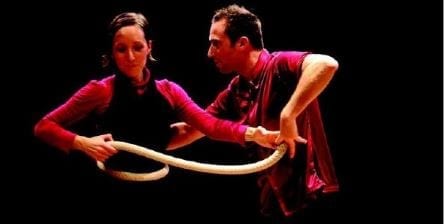PROVO — Last year BYU took a chance on an idea: creating a new international arts festival. The hope was that Utahns would embrace innovative, modern theatre productions from around the world while giving students the chance to study the techniques and ideas that are virtually unknown in America.
The gamble paid off, and last year’s Off the Map festival was a success. With hopes of repeating that success, BYU has imported companies from France, New Zealand, and China to present another set of innovate, groundbreaking performances.
Linéa
Coming from France, Linéa is a wordless production that almost defies description. Part juggling act, part dance performance, part pantomime, part romance, part puppeteering act, and part comedy, Linéa is a show that combines familiar performing disciplines in new and unexpected way. There is only the barest skeleton of a plot: a woman and a man—already a couple when the show starts—trying to overcome their differences. Kim Huynh and Jive Faury are the creators and only two performers in the show, which relies on varies lengths of rope to tell a visually entrancing story.
Huynh is the impish woman in this story who wants to dance with her man, played by Faury. Her grace and eagerness in every minute of the show gives it an energy that can only come from a fully committed performer. Without speaking a word Huynh brought a playfulness to Linéa that made the comic portions of the production soar. Faury is the show’s anchor, and his knack for using a subtle change of facial expression to convey a new idea or a turning point in the story is remarkable. Faury’s physical dedication to Linéa never ceases, and at the peak of the juggling in the show it was clear that watching Faury’s virtuosity was almost like watching a professional athlete execute a spectacular play. But it is simply not fair to talk about the two performers separately. Having conceived the show together and being on stage the entire time together with flirtatious chemistry, they operate as one for all of Linéa.
Another memorable aspect of Linéa is the various lengths of rope (from a few feet to 100 yards) that serve as dance aids, juggling clubs, and more. In fact, at various times the ropes seem play the saxaphone, dance, express emotion, rolls, bounces, and almost have a personality. And, like any good puppeteer, Huynh and Faury sometimes create such compelling visual images that make them almost disappear as they shift a viewer’s focus to the spectacle.
Linéa is so innovative and unusual that for the first third of the 50-minute production I found myself unable to understand the production as a traditional American-style play. Having reviewed live theatre for eight years I have a system that works very well for organizing my thoughts as I prepare a review. Yet I had difficulty assimilating this show for the first twenty minutes because it transcends so many genres. Even though Linéa simply doesn’t fit into the framework of a traditional American piece of theatre, the show isn’t confusing or artsy for the sake of artsy-ness. Rather, it’s a jovial, lighthearted production that is suitable for all ages.
The Elephant Wrestler
The most international production at this year’s Off the Map is The Elephant Wrestler. Coming from New Zealand, the show takes place in India and tells the story of a poor chai (tea) seller named Kurisa in Bangalore, whose life changes when a group of sisters sing near his shop. Eventually the sisters marry and move away until the youngest, named Balna, is left alone. Unfortunately, the city is ruled by an organized crime lord known only as “The Fakir,” the nemesis of a benevolent policeman named Punshkin. The Elephant Wrestler is the most traditional event at Off the Map, which may make it a good choice for audience members who prefer the conventions of American theatre.
Jacob Rajan (who was also one of playwrights) plays all the characters in this sprawling story, although he spends most of his time as Kurisa, the narrator of the tale. Kurisa is easiest to understand as the Tevye of India. Like Tevye, Kurisa is poor, puts his own clever twist on cultural wisdom, and is deeply concerned for the well-being of his girls. Rajan makes Kurisa an imminently sympathetic character, and a pleasant person to spend 90 minutes with.
Where the production falls short is in its attempt to square the circle of a sprawling story with roughly 20 characters, spanning about 25 years, with the cast of one (or two, including the on-stage musician, David Ward, who never speaks). To accomplish this, Rajan must transition among characters quickly and efficiently. Unfortunately, there are rarely enough differences in Rajan’s voice or demeanor to make it immediately clear which is the persona that Rajan has adopted. This isn’t to say that Rajan is incapable; rather, I would prefer not to have to ask myself “Which character is he now?” after a change, which distracted me from the story.
Rajan and his fellow playwright, Justin Lewis (who also directed The Elephant Wrestler) have created an emotionally engrossing story that has plenty of rising tension. The only fault in the script is that Kurisa is the only character that is fully developed, yet he is not the one in the greatest danger. Putting two secondary characters—Balna and Punshkin—in the greatest danger makes for a lower stakes conflict. Furthermore, I predicted the final plot twist when the play had not yet reached its midpoint, which made the climax less gripping than it could have been.
Nevertheless, the work Rajan and his colleagues at the India Ink Theatre Company is still immensely enjoyable, and the ease at which Rajan can harness the power of imagination to recreate the far-off setting of his story is undeniable. The tragedy of the story has the ability to generate sympathy and genuine emotion, and a ticket to this play is grossly underpriced.
The Shanghai Restoration Project
The last event of this year’s Off the Map is the Shanghai Restoration Project, a music group based in New York City that infuses traditional Chinese music with hip-hop, jazz, and pop to create an interesting blend of eastern and western sounds. Because the group makes no pretense of creating theatre and BYU advertises this event as a concert, I will not critique this production. (After all, I am a theatre critic, not a music critic. I know my limitations.) But as a part of the Off the Map package it needs to be mentioned, and the mixing of cultures may be interesting to some readers.








